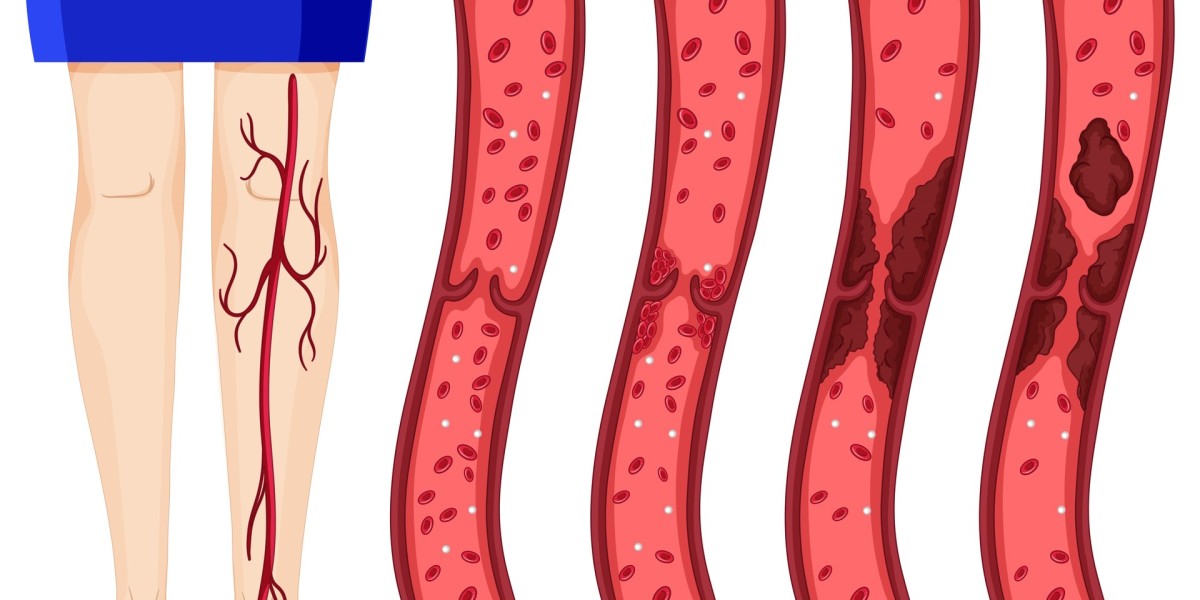Introduction
Have you ever noticed sudden swelling, warmth, or discomfort in your leg and brushed it off as muscle strain or fatigue? While these symptoms can be harmless, they might also signal something more dangerous — a blood clot in the leg.
Blood clots that form deep inside the veins, especially in the legs, are called Deep Vein Thrombosis (DVT). They can develop quietly and lead to life-threatening complications like pulmonary embolism if left untreated. That’s why it’s essential to understand the signs and act early.
This article will guide you step-by-step through how to recognize blood clot in leg symptoms: a complete guide — including what causes them, who is at risk, and what you can do to stay safe.
What Is a Blood Clot in the Leg?
A blood clot is a semi-solid mass of blood that forms when the body’s clotting process is triggered. While clotting is necessary to prevent bleeding, sometimes clots form in places where they shouldn't — such as in the deep veins of the leg.
When a clot forms in a deep vein (most commonly in the lower leg, thigh, or pelvis), it can block blood flow and lead to deep vein thrombosis (DVT). If the clot breaks loose and travels to the lungs, it becomes a pulmonary embolism (PE), which can be fatal.
Common Causes of Leg Blood Clots
Understanding what causes a blood clot in the leg helps in both prevention and early detection. Here are some of the most common triggers:
Prolonged immobility (e.g., during flights, long car rides, or bed rest)
Recent surgery or trauma, especially in the hips or legs
Pregnancy and postpartum period
Smoking, which damages blood vessels
Obesity, which puts pressure on leg veins
Cancer or cancer treatments
Certain medications, like hormone replacement therapy or birth control
Genetic clotting disorders
Dehydration, which thickens the blood
How to Recognize Blood Clot in Leg Symptoms: A Complete Guide
Detecting the early signs of DVT can save your life. These symptoms can appear in isolation or together, and their intensity may vary.
1. Unexplained Swelling in One Leg
Swelling is often the first noticeable symptom. It usually occurs in one leg and may extend from the ankle up to the thigh. The leg may appear puffy or tight, and you might feel discomfort when standing or walking.
2. Pain or Tenderness
This pain can feel like a cramp or soreness in the calf or thigh. Unlike typical muscle pain, it doesn’t go away with stretching or massage. The tenderness is often constant and may worsen when walking.
3. Warmth Over the Affected Area
Touching the swollen area may feel noticeably warmer than the surrounding skin. This warmth is a result of inflammation caused by the clot obstructing normal blood flow.
4. Red or Discolored Skin
The skin over the clot may appear red or bluish-purple. Sometimes the area looks shiny, especially if swelling is severe. This is often mistaken for a rash or bruising.
5. Visible Veins or Vein Hardening
In some cases, surface veins become more visible or feel firm and rope-like. This may indicate the deeper veins are blocked.
6. Leg Fatigue or Heaviness
Many patients report a dull ache or heaviness that feels unusual. Even light activity can feel tiring for the affected leg.
Important: If you experience any of these symptoms — especially in combination — it’s critical to seek medical attention right away. Early diagnosis and treatment can prevent complications.
Risk Factors You Should Know
Even if you're not experiencing symptoms, it’s wise to know whether you’re at higher risk. You may be more likely to develop a leg clot if:
You are over the age of 60
You recently had surgery or were hospitalized
You take hormonal medications (like birth control)
You are pregnant or recently gave birth
You have a family history of clotting disorders
You sit for extended periods (travelers, desk jobs)
You are overweight or obese
You smoke
How Is DVT Diagnosed?
Doctors use several tests to confirm the presence of a blood clot:
✅ Ultrasound
The most common test, it uses sound waves to create an image of blood flow in the veins.
✅ D-dimer Test
A blood test that detects fragments produced when a clot dissolves. High levels may indicate DVT.
✅ Venography
A special dye is injected into a vein to provide a clearer image on X-ray.
✅ MRI or CT Scan
Used in more complex or high-risk cases to view deeper veins or rule out a pulmonary embolism.
What Happens If You Ignore It?
If a DVT is left untreated, the clot can grow and travel to your lungs — causing a pulmonary embolism (PE). Symptoms of PE include:
Sudden shortness of breath
Chest pain or tightness
Coughing up blood
Rapid heart rate
Dizziness or fainting
A PE can be fatal if not treated immediately. That’s why it’s so important to catch and treat blood clots early.
Treatment Options for Blood Clots in the Leg
Anticoagulants (Blood Thinners)
These help prevent the clot from growing and reduce the risk of new clots. Medications include warfarin, rivaroxaban, or apixaban.
Thrombolytics
In severe cases, doctors may use clot-busting drugs to dissolve the clot faster. This is usually done in a hospital setting.
Compression Stockings
These special stockings improve blood flow in the legs and reduce swelling and discomfort.
Lifestyle Adjustments
Staying active, maintaining a healthy weight, avoiding smoking, and staying hydrated can help reduce your risk of future clots.
Prevention Tips: Stay a Step Ahead
Even if you’ve never had a blood clot, prevention is key:
Move around regularly, especially during travel or long periods of sitting.
Elevate your legs when resting to encourage blood flow.
Drink plenty of water to keep your blood thin and flowing.
Wear compression socks if you’re at high risk or post-surgery.
Avoid smoking and maintain a healthy weight.
Talk to your doctor before long flights, surgeries, or starting hormone medications.
Real Case Highlight
Anita, a 38-year-old IT professional from Bangalore, noticed a dull ache in her right calf after a long flight. She assumed it was stiffness from sitting too long, but when swelling and redness followed, she visited her doctor. An ultrasound confirmed DVT. Thanks to early diagnosis and treatment, Anita recovered fully and now wears compression socks during travel.
Her story is a reminder that even young, active people can be at risk — and why it's so important to know the signs.
Conclusion
Leg pain or swelling might not seem like a big deal — until it is. Deep vein thrombosis is more common than most people think, and its consequences can be deadly. That’s why learning how to recognize blood clot in leg symptoms: a complete guide is essential for your health and safety.
If you notice sudden leg pain, swelling, or skin changes, don’t wait. Consult a medical professional immediately. The sooner you act, the better your chances of avoiding serious complications.








